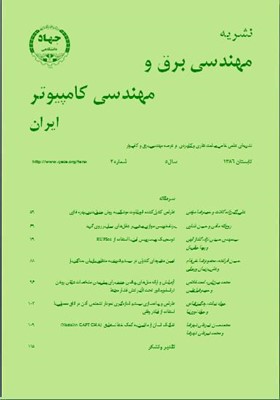تفکيک انسان از ماشين به کمک خط نستعليق (Nastaliq CAPTCHA)
محورهای موضوعی : مهندسی برق و کامپیوترمحمدحسن شیرعلی شهرضا 1 * , محمد شیرعلی شهرضا 2
1 - دانشگاه یزد
2 - دانشگاه صنعتي شريف
کلید واژه: آزمون تورینگامنیت شبکهتفکیک کاربران انسانی از نرمافزارهای رایانهای (CAPTCHA) سیستمهای تشخیص حروف (OCR),
چکیده مقاله :
امروزه بسیاری از فعالیتهای روزمره انسانها همچون آموزش، تجارت، گفتگو و غیره از طریق اینترنت صورت میگیرد. در مواردی همچون ثبتنام در پایگاههای اینترنتی، بعضی افراد خرابكار با نوشتن نرمافزارهای رایانهای، اقدام به ثبتنام جعلی در این پایگاهها میكنند كه موجب هدررفتن منابع پایگاه میشود. لذا باید به تفكیك كاربران انسانی از نرمافزارهای رایانهای پرداخت. بدین منظور در این مقاله روشی برای تفكیك كاربران فارسی و عربی زبان از نرمافزارهای رایانهای بر پایه خط نستعلیق ارائه شده است. در این روش تصویری از یك كلمه فارسی یا عربی كه با خط نستعلیق نوشته شده انتخاب گردیده، برای كاربر نمایش داده شده و از وی خواسته میشود تا آن كلمه را تایپ كند. با توجه به عدم توانایی شناسایی این كلمات توسط نرمافزارهای تشخیص حروف فارسی و عربی موجود، امكان تشخیص این كلمات تنها توسط یك كاربر فارسی یا عربی زبان امكانپذیر میباشد. روش پیشنهادی توسط زبان جاوا پیادهسازی شده است.
Nowadays, many daily human activities such as education, trade, talks, etc are done by using the Internet. In such things as registration on Internet web sites, hackers write programs to make automatic false registration that waste the resources of the web sites while it may also stop it from functioning. Therefore, human users should be distinguished from computer programs. To this end, this paper presents a method for distinction of Persian and Arabic-language users from computer programs based on Persian and Arabic texts using Nastaliq font. In this method, the image of a Persian or Arabic word written in Nastaliq font is chosen from a dictionary, and it is shown to the user, then he is asked to type it. Considering that the presently available Persian and Arabic OCR programs cannot identify these words, the word can be identified only by a Persian or Arabic-language user. The proposed method has been implemented by the Java language.
[1] G. Mori and J. Malik, "Recognizing objects in adversarial clutter: breaking a visual CAPTCHA," in Proc. of the IEEE CS Society Conf. on Computer Vision and Pattern Recognition (CVPR'03), pp. 134-141, Madison, US, Jun. 2003.
[2] G. Moy, N. Jones, C. Harkless, and R. Potter, "Distortion estimation techniques in solving visual CAPTCHAs," in Proc. of the 2004 IEEE Computer Society Conf. on Computer Vision and Pattern Recognition (CVPR'04), vol. 2, pp. 23-28, Jun./Jul. 2004.
[3] H. S. Baird and K. Popat, "Human interactive proofs and document image analysis," in Proc. of the 5th IAPR International Workshop on Document Analysis Systems, pp. 507-518, Princeton, US, Aug. 2002.
[4] M. Blum, L. A. Von Ahn, and J. Langford, Completely Automatic Public Turing Test to Tell Computers and Humans Apart, The CAPTCHA Project, www.captcha.net, Deptartment of Computer Science, Carnegie-Mellon University, 2000.
[5] M. Chew and H. S. Baird, "Baffletext: a human interactive proof," in Proc. of the 10th SPIE/IS&T Conf. on Document Recognition and Retrieval (DR&R2003), pp. 305-316, Santa Clara, US, Jan. 2003.
[6] A. Rusu and V. Govindaraju, "Handwritten CAPTCHA: using the difference in the abilities of humans and machines in reading handwritten words," in Proc. of the 9th International Workshop on Frontiers in Handwriting Recognition (IWFHR-9), pp. 226-231, Oct. 2004.
[7] PayPal Registration, in URL: http://www.paypal.com/
[8] W. Liao and C. Chang, "Embedding information within dynamic visual patterns," in Proc. of the IEEE International Conf. on Multimedia and Expo 2004 (ICME'04), vol. 2, pp. 895-898, Jun. 2004.
[9] Microsoft Hotmail, in URL: http://www.hotmail.com/
[10] A. L. Coates, H. S. Baird, and R. J. Fateman, "Pessimal print: a reverse turing test," in Proc. of the 6th International Conf. on Document Analysis and Recognition, pp. 1154-1158, Seattle, US, Sep. 2001.
[11] H. S. Baird and T. Riopka, "Scattertype: a reading CAPTCHA resistant to segmentation attack," in Proc. of the IS&T/SPIE Conf. on Document Recognition & Retrieval XII (DR&R2005), pp. 197-207, San Jose, US, Jan. 2005.
[12] H. S. Baird and J. L. Bentley, "Implicit CAPTCHAs," in Proc. of the SPIE/IS&T Conf. on Document Recognition and Retrieval XII (DR&R2005), pp. 191-196, San Jose, US, Jan. 2005.
[13] T. Y. Chan, "Using a text-to-speech synthesizer to generate a reverse turing test," in Proc. of the 15th IEEE Int. Conf. on Tools with Artificial Intelligence, pp. 226-232, Nov. 2003.
[14] M. Shirali-Shahreza and S. Shirali-Shahreza, "Drawing CAPTCHA," in Proc. of the 28th Int. Conf. Information Technology Interfaces (ITI 2006), pp. 475-480, Cavtat, Croatia, Jun. 2006.
[15] م. شیرعلی شهرضا، تشخيص ارقام و كلمات دستنويس فارسي به كمك شبكههاي عصبي، پایاننامه دوره دکترا، دانشکده مهندسی برق، دانشگاه صنعتی امیرکبیر، 1374.
[16] ح. فضائلي، اطلس خط، انتشارات سروش، چاپ ششم، تهران، 1370.

